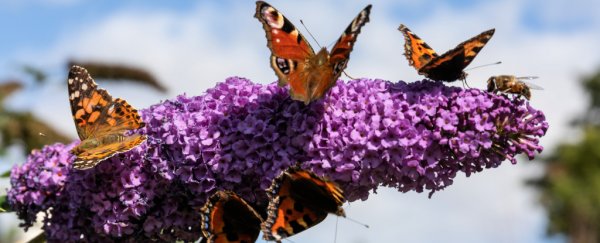If you've been on social media this week, you might have noticed Californians going crazy over the sudden appearance of millions of butterflies, flying north en masse through the state. It's pretty much the exact joyful display of nature that the world needs right now.
But it's also a beautiful and rare sight in a world where insects are disappearing more rapidly than ever before. Experts are saying there hasn't been this kind of butterfly migration through the state since 2005.
So what's going on?
Contrary to what some people are posting, these aren't monarch butterflies: they're painted lady butterflies. And this is part of their annual migration in the Americas.
Butterfly in the skkkyyy... #paintedladies @WindwardSchool pic.twitter.com/4YYV107br0
— Melanie Arias, Ph.D. (@20thC_Melanie) March 12, 2019
Every winter, these incredible, brightly coloured butterflies mature in the Californian and Mexican deserts before heading north altogether for the summer - travelling at a breakneck 25 miles per hour (40 kilometres per hour) and barely stopping.
The migration is so coordinated that last year, weather forecasters freaked out over an unexplained, city-sized 'blob' appearing on their radars. It turned out to be painted ladies.
But while this migration is an annual event, this year is pretty special for California.
Experts are saying the state hasn't had this many passing through since 2005, when 1 billion painted ladies flew past on their way north.
I’ve never seen so many Butterflies in my life! They keep coming and are all heading north. It’s absolutely stunning! #Butterflymigration pic.twitter.com/aiZQGJyCrS
— Matt Acevedo (@TheMattAcevedo) March 12, 2019
The reason their numbers have boomed is all the unseasonable rain in the desert so far this year, which triggered a recent flower 'superbloom'.
While we still don't know a whole lot about the life cycle of the butterflies, we know they lay their eggs on plants and also feed on those plants after they're born - so the more flowers there are, the more butterflies we get.
"When they are scarce nobody notices them," ecologist Art Shapiro from the University of California, Davis, told Deborah Netburn over at the LA Times.
"When they are abundant, everyone notices."
That's definitely the case this year, with what feels like everyone in California (including Taylor Swift) posting about the butterflies filling the Californian skies.
Fun fact: Over in Europe the migration is even more epic, with painted ladies completing the farthest known butterfly migration in the world, flying 7,500 miles or 12,000 kilometres and crossing the Sahara.
Unfortunately, we might not see this type of butterfly explosion in future years.
While scientists have been concerned about the decline of flying insects for years, a study earlier this year showed just how dire the situation has become.
As David Nield reported for ScienceAlert:
"A newly published review of 73 reports on insect decline around the world has found that over 40 percent of insect species are threatened with extinction. For some comparison, that rate of local species extinction is eight times faster than we're seeing in vertebrates such as mammals, birds, and reptiles."
Scientists still aren't quite sure exactly what is driving these insect deaths, with pesticides, climate change, and habitat loss all implicated.
Let's hope this beautiful experience might make more people care about the plight of these incredible insects, and what we can do to protect them while they're still around.
